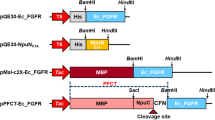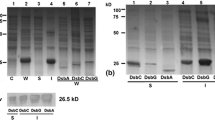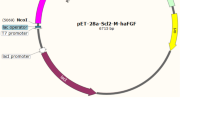Abstract
Fibroblast growth factor receptor 3 (FGFR3) is a noted proto-oncogene involved in the pathogenesis of many tumors, so more and more studies focus on the potential use of receptor kinase inhibitor and therapeutic antibodies against FGFR3. In this study, we designed a novel fusion protein containing the single-chain Fv (ScFv) against FGFR3 and 9-arginine, denoted as ScFv-9R. To achieve the high-level production and soluble expression, ScFv and ScFv-9R were fused with small ubiquitin-related modifier (Sumo) by polymerase chain reaction and expressed in Escherichia coli BL21 (DE3). The recombinant bacteria was induced by 0.5 mM isopropyl-β-d-thiogalactopyranoside for 20 h at 20 °C; supernatants of Sumo-ScFv was harvested and purified by DEAE Sepharose FF and Ni-NTA orderly, and supernatants of Sumo-ScFv-9R was harvested and purified by Ni-NTA. After cleaved by the Sumo protease, the recombinant ScFv or ScFv-9R was released from the fusion protein, respectively. The purity of ScFv or ScFV-9R was shown to be higher than 90 %, and their yield reached 3–5 mg per liter of bacterial culture. In vitro data showed that ScFV-9R can attenuate the phosphorylation of FGFR3 and ERK in the absence or presence of FGF9. Gel retardation assay showed that 1 μg of ScFv-9R could efficiently bind to about 4 pmol siRNA. Fluorescent microscope analysis showed that ScFv-9R can efficiently bind and deliver siRNA into RT112 cells. In conclusion, we use Sumo fusion system to acquire high-level production, soluble expression, and bifunctional activity of ScFv-9R in E. coli. Our results also revealed that ScFv-9R, as a novel carrier, may have potential applications in antitumor studies and pharmaceutical development.








Similar content being viewed by others
References
Chung SS, Koh CJ (2013) Bladder cancer cell in co-culture induces human stem cell differentiation to urothelial cells through paracrine FGF10 signaling. Vitro Cell Dev Biol Anim 49(10):746–751
Di Martino E, Tomlinson DC, Knowles MA (2012) A decade of FGF receptor research in bladder cancer: past, present, and future challenges. AdvUrol 2012:429213
Du X, Wang QR, Chan E, Merchant M, Liu J, French D, Ashkenazi A, Qing J (2012) FGFR3 stimulates stearoyl CoA desaturase 1 activity to promote bladder tumor growth. Cancer Res 72(22):5843–5855
Glénisson M, Vacher S, Callens C, Susini A, Cizeron-Clairac G, Le Scodan R, Meseure D, Lerebours F, Spyratos F, Lidereau R, Bièche I (2012) Identification of new candidate therapeutic target genes in triple-negative breast cancer. Genes Cancer 3(1):63–70
Jäger V, Büssow K, Wagner A, Weber S, Hust M, Frenzel A, Schirrmann T (2013) High level transient production of recombinant antibodies and antibody fusion proteins in HEK293 cells. BMC Biotechnol 13(1):52
Li X, Stuckert P, Bosch I, Marks JD, Marasco WA (2001) Single-chain antibody-mediated gene delivery into ErbB2-positive human breast cancer cells. Cancer Gene Ther 8(8):555–565
Liu X, Chen Y, Wu X, Li H, Jiang C, Tian H, Tang L, Wang D, Yu T, Li X (2012) SUMO fusion system facilitates soluble expression and high production of bioactive human fibroblast growth factor 23 (FGF23). Appl Microbiol Biotechnol 96(1):103–111
Marblestone JG, Edavettal SC, Lim Y, Lim P, Zuo X, Butt TR (2006) Comparison of SUMO fusion technology with traditional gene fusion systems: enhanced expression and solubility with SUMO. Protein Sci 15(1):182–189
Martínez-Torrecuadrada J, Cifuentes G, López-Serra P, Saenz P, Martínez A, Casal JI (2005) Targeting the extracellular domain of fibroblast growth factor receptor 3 with human single-chain Fv antibodies inhibits bladder carcinoma cell line proliferation. Clin Cancer Res 11(17):6280–6290
Martínez-Torrecuadrada JL, Cheung LH, López-Serra P, Barderas R, Cañamero M, Ferreiro S, Rosenblum MG, Casal JI (2008) Antitumor activity of fibroblast growth factor receptor 3-specific immunotoxins in a xenograft mouse model of bladder carcinoma is mediated by apoptosis. Mol Cancer Ther 7(4):862–873
Plowright EE, Li Z, Bergsagel PL, Chesi M, Barber DL, Branch DR, Hawley RG, Stewart AK (2000) Ectopic expression of fibroblast growth factor receptor 3 promotes myeloma cell proliferation and prevents apoptosis. Blood 95(3):992–998
Qing J, Du X, Chen Y, Chan P, Li H, Wu P, Marsters S, Stawicki S, Tien J, Totpal K, Ross S, Stinson S, Dornan D, French D, Wang QR, Stephan JP, Wu Y, Wiesmann C, Ashkenazi A (2009) Antibody-based targeting of FGFR3 in bladder carcinoma and t(4;14)-positive multiple myeloma in mice. J Clin Invest 119(5):1216–1229
Song E, Zhu P, Lee SK, Chowdhury D, Kussman S, Dykxhoorn DM, Feng Y, Palliser D, Weiner DB, Shankar P, Marasco WA, Lieberman J (2005) Antibody mediated in vivo delivery of small interfering RNAs via cell-surface receptors. Nat Biotechnol 23(6):709–717
Sonvilla G, Allerstorfer S, Heinzle C, Stättner S, Karner J, Klimpfinger M, Wrba F, Fischer H, Gauglhofer C, Spiegl-Kreinecker S, Grasl-Kraupp B, Holzmann K, Grusch M, Berger W, Marian B (2010) Fibroblast growth factor receptor 3-IIIc mediates colorectal cancer growth and migration. Br J Cancer 102(7):1145–1156
Trudel S, Stewart AK, Rom E, Wei E, Li ZH, Kotzer S, Chumakov I, Singer Y, Chang H, Liang SB, Yayon A (2006) The inhibitory anti-FGFR3 antibody, PRO-001, is cytotoxic to t(4;14) multiple myeloma cells. Blood 107(10):4039–4046
Wang H, Xiao Y, Fu L, Zhao H, Zhang Y, Wan X, Qin Y, Huang Y, Gao H, Li X (2010) High-level expression and purification of soluble recombinant FGF21 protein by SUMO fusion in Escherichia coli. BMC Biotechnol 10:14
Wang W, Luo J, Xu L, Zeng J, Cao L, Dong J, Cai S (2013) Expression of scFv-Mel-Gal4 triple fusion protein as a targeted DNA-carrier in Escherichia coli. Cell Biochem Funct. doi:10.1002/cbf.2958
Ware KE, Marshall ME, Heasley LR, Marek L, Hinz TK, Hercule P, Helfrich BA, Doebele RC, Heasley LE (2010) Rapidly acquired resistance to EGFR tyrosine kinase inhibitors in NSCLC cell lines through de-repression of FGFR2 and FGFR3 expression. PLoS One 5(11):e14117
Wen WH, Liu JY, Qin WJ, Zhao J, Wang T, Jia LT, Meng YL, Gao H, Xue CF, Jin BQ, Yao LB, Chen SY, Yang AG (2007) Targeted inhibition of HBV gene expression by single-chain antibody mediated small interfering RNA delivery. Hepatology 46(1):84–94
Wesche J, Haglund K, Haugsten EM (2011) Fibroblast growth factors and their receptors in cancer. Biochem J 437(2):199–213
Yao YD, Sun TM, Huang SY, Dou S, Lin L, Chen JN, Ruan JB, Mao CQ, Yu FY, Zeng MS, Zang JY, Liu Q, Su FX, Zhang P, Lieberman J, Wang J, Song E (2012) Targeted delivery of PLK1-siRNA by ScFv suppresses Her2+ breast cancer growth and metastasis. SciTransl Med 4(130):130ra48
Ye Q, Hu H, Wang Z, Lu T, Hu Z, Zeng X, Zhang S, Liu J, Lei P, Wang CY, Ye Z, Shen G (2012) Generation and functional characterization of the anti-transferrin receptor single-chain antibody-GAL4 (TfRscFv-GAL4) fusion protein. BMC Biotechnol 12:91
Acknowledgments
This work was supported by National Natural Science Foundation of China (No.81370640), the key Science & technology funding of Jilin province (20130206003YY) and biopharmaceutical grant from Jilin provincial Science & technology department (20130727041YY).
Author information
Authors and Affiliations
Corresponding authors
Electronic supplementary material
Below is the link to the electronic supplementary material.
ESM 1
(PDF 232 kb)
Rights and permissions
About this article
Cite this article
Zhang, X., Xie, J., Sun, Y. et al. High-level expression, purification, and characterization of bifunctional ScFv-9R fusion protein. Appl Microbiol Biotechnol 98, 5499–5506 (2014). https://doi.org/10.1007/s00253-014-5541-x
Received:
Revised:
Accepted:
Published:
Issue Date:
DOI: https://doi.org/10.1007/s00253-014-5541-x




